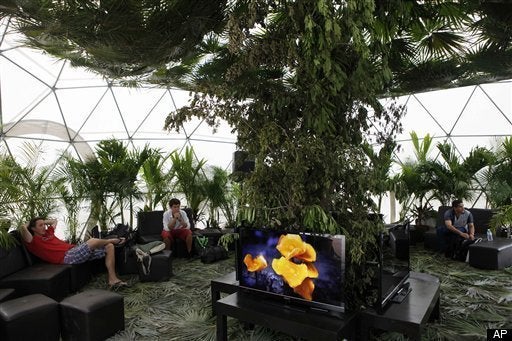
Cancun -- As more than 190 government delegations gather in Cancun, Mexico, for the global climate talks, one topic isn't on the menu in any substantial portion: the intensive system of rearing animals for food known as factory farming. But conference delegates ignore the rapid spread of intensive animal agriculture at the planet's -- and millions of people's -- peril.
Approximately 18 percent of climate-warming greenhouse gases (GHGs) can be attributed to the livestock industry, according to the Food and Agriculture Organization of the United Nations. That's almost equal to the GHG toll from destruction or degradation of the world's forests. A more recent estimate by current and former World Bank environmental specialists puts livestock's share of GHGs much higher, at 51 percent of the global total.
A vast number of animals -- approximately 60 billion -- are used in food production around the world every year. As the global farmed animal population increases (to perhaps 100 billion by 2050, if current trends persist), and with it, the number of factory farms and feedlots, GHG emissions will rise exponentially, too.
GHGs are generated at every stage of livestock production: carbon dioxide through the transport of animals, powering mechanized facilities, and producing chemical fertilizers to grow "feed" grains. Large quantities of methane are released by enteric fermentation -- the digestive processes of cows -- and by animals' manure.
Methane has more than 20 times the global warming potential of carbon dioxide and a much shorter lifespan in the atmosphere; if quantities were reduced rapidly, the global warming effect would be substantial. Animals' manure also emits nitrous oxide, a GHG with nearly 300 times carbon dioxide's warming potential.
Brazil, China, and India are all emerging economic powers. Each is playing a central role in the direction of the Cancun talks. Each is also a crucial force shaping 21st century animal agriculture -- and with it, climate realities, too. Ethiopia, although far from a fast-food nation, is Africa's largest producer and exporter of livestock.
In all four countries, as in others in the global South, a growing share of water, grain, land, forests, and climate "space" are being directed to the meat and dairy industries. This is coming at a considerable cost, not only to the global climate, but also to food security, ecological sustainability, livelihoods, equity, animal welfare, and public health at the national level.
Brazil, an agricultural powerhouse, is the world's largest exporter of beef and chicken, and a lead exporter of soy for farmed animal feed. Brazil's expanding livestock sector is intimately linked with global markets for agricultural commodities -- be they beef, poultry, pork, soybeans, or leather. During the global recession, rates of deforestation in Brazil dropped to their lowest levels in 20 years. But as demand for commodities like beef and soy edged back up in 2010, deforestation levels doubled from those in 2009.
Brazil is the world's most biologically diverse nation. It is also the world's fourth-largest emitter of GHGs, principally due to the burning of its forests for agricultural expansion. According to a report by Friends of the Earth-Amazonia, the Brazilian National Instiitute for Space Research, and the University of Brasília concluded that fully half of Brazil's GHG emissions between 2003 and 2008 came from the cattle sector alone.
Only two generations after a devastating national famine, China is eating increasingly high on the food chain. Over the past decade, consumption of China's most popular meat, pork, has doubled. In 2007, China raised well over half a billion pigs. China, the world's largest emitter of GHGs, has committed to increasing its production of pork and to expanding meat exports, even as domestic food prices rise and animal agriculture has become a major source of serious water pollution.
While ethical vegetarianism has a several-thousand-year history in India, more than half of India's 1.17 billion people now consider themselves omnivores. India's booming middle class is driving up demand for meat, eggs, and dairy products. India has the world's largest dairy herd, 300 million strong, and is the world's third largest producer of eggs and sixth largest producer of poultry meat.
Ethiopia, at a very different level of development, is nonetheless looking to produce more meat and dairy products for export, although food security for its fast-growing population remains elusive and soil erosion and land degradation are extensive.
At the same time, Brazil, China, Ethiopia, and India are experiencing the effects of climate change -- more frequent drought and floods, higher temperatures, and increasingly erratic weather -- all of which will challenge their ability to produce enough food and to sustain expanding human and animal populations.
It's increasingly clear that food and agricultural need to be central to climate policy, including any agreements on stemming deforestation, transferring green technologies, and funding poorer countries' adaptation to global warming.
Continuing to marginalize animal agriculture in international debates over climate policy means forfeiting a crucial opportunity to reduce global GHGs and to create a more sustainable, equitable, humane, and climate-compatible food system. There are NGOs in Cancun sharing pieces of this message. Will governments offer them a place at the table? If they don't, it looks like more bitter harvests ahead.
